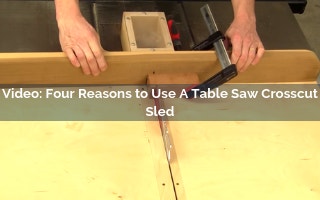Video: Four Reasons to Use A Table Saw Crosscut Sled

Every table saw comes with a miter gauge, and they’re made for making crosscuts and angled cuts. So why do you need a crosscut sled? There are four good reasons why a crosscut sled can improve your safety and accuracy at the table saw. Chris Marshall will show you all four in this video. So, whether you’re crosscutting big stock or little tiny workpieces, or making repetitive cuts or angled cuts. A crosscut sled can improve your safety and accuracy at the table saw.
Skill Builder Video
Video: Four Reasons to Use A Table Saw Crosscut Sled - Video Transcript
Chris Marshall: Every table saw comes with a miter gauge and they are made for making crosscuts and angle cuts. You might wonder: Why do I need one of these crosscut sleds? I'm going to give you four good reasons why a crosscut sled can improve your safety and accuracy at your table saw. The first reason has to do with bad friction against the saw table. You know that whenever you're using a miter gauge to cut workpieces of any size, all of this material is laying flat down on the saw table.
As you push workpieces through the cut you're having to hold them against the miter gauge and down against the table, and that just adds friction. If you don't have a good grip, they can actually slip out of alignment with the blade and that affects your accuracy, particularly if the workpiece has a rough or slippery surface like this melamine. The problem just gets worse as workpieces get longer, wider and heavier.
Miter gauges are just too small to handle work like this but a crosscut sled works differently. It has a large base to support workpieces during the cut so they don't make contact with the saw table at all. Eliminating that contact and friction means workpieces can't easily shift out of place during a cut whether they're wide, long, or heavy. Now the second reason for crosscut sleds has to do with safety.
How do you crosscut a little workpiece like this with a miter gauge? There is just no good way to hold this without getting your fingers too close to the blade. While a scrap fence gives you a place to clamp it, I still think that a crosscut sled is the better option. Once again the sled's base here does all the sliding during the cut so the workpiece remains stationary and its back fence provides a clamping surface to keep your fingers out of harm's way.
The third great thing about crosscut sleds is repeatability. Sooner or later you're going to want to cut a bunch of parts to the exact same length. Whether that's chair slats, retainer strips for glass, drawer box parts, or what have you. A crosscut sled makes repetitive cuts easy. An adjustable stop like the one in this crosscut sled from Rockler makes repetitive cuts a cakewalk.
Just set the stop where you want it and every cut will be indexed the exact same distance from the blade. If your crosscut sled doesn't have an adjustable stop like this on it, no big deal. Just clamp a scrap block to the fence instead, it will do the same job. Finally, there's angle cuts and that's the fourth big advantage to a crosscut sled. We all want to be able to cut accurate miters for picture frames and so forth.
You can't cut them with a miter gauge but friction works against you here too. When you rotate the fence to cut a miter like this, and then slide the workpiece through it's even more likely to slide out of position because this back support is reduced. That's where crosscut sleds with pivoting fences like this are super helpful. They act like giant miter gauges only with much greater angle setting precision and with no friction issues for the workpiece.
The larger this protractor scale is, the more accurate these angle settings can become. As a comparison, let's say I wanted to find 47 and a half degrees here on my miter gauge. It's somewhere right in here, but I'm not exactly sure. There is no need to guess on a giant protractor scale like this; 45, 46, 47 and a half. It's right there. So whether you're crosscutting big stock or little tiny workpieces, making repetitive cuts or angled cuts, you've got four good reasons to either build a crosscut sled or buy one, and put it to good use on your table saw. I'm Chris Marshall with Woodworker's Journal magazine, and thanks for watching.
Keep the inspiration coming!
Subscribe to our newsletter for more woodworking tips and tricks



